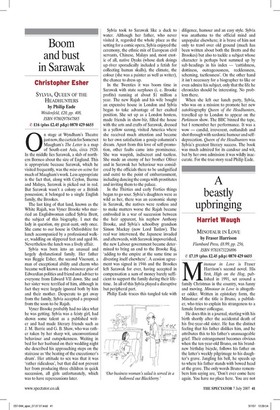Boom and bust in Sarawak
Christopher Esher SYLVIA, QUEEN OF THE HEADHUNTERS by Philip Eade Weidenfeld, £20, pp. 408, ISBN 9780297847885 £16 (plus £2.45 p&p) 0870 429 6655 n stage at Wyndham's Theatre just now, the curtain for Somerset Maugham's The Letter is a map of South-east Asia, circa 1920. In the middle lies Sarawak, a slab of northern Borneo about the size of England. This is appropriate because Sarawak, which he visited frequently, was the mise-en-scene for much of Maugham's work. Less appropriate is the fact that, along with Ceylon, Burma and Malaya, Sarawak is picked out in red. But Sarawak wasn't a colony or a British possession; it belonged to a single English family, the Brookes.
The last king of that land, known as the White Rajah, was Vyner Brooke who married an Englishwoman called Sylvia Brett, the subject of this biography. I met the lady in question, my great-aunt, only once. She came to our house in Oxfordshire for lunch accompanied by a professional walker, waddling on slippered feet and aged 86. Nevertheless the lunch was a lively affair.
Sylvia was born into an unusual and largely dysfunctional family. Her father was Reggie Esher, the second Viscount, a man of exceptional ability and charm who became well known as the eminence grise of Edwardian politics and friend and adviser to everyone from Edward VII down. She and her sister were terrified of him, although in fact they were largely ignored both by him and their mother. Desperate to get away from the family, Sylvia accepted a proposal from the soon-to-be Rajah.
Vyner Brooke probably had no idea what he was getting. Sylvia was a feisty girl, had shown some talent as a published writer and had made literary friends such as J. M. Barrie and G. B. Shaw, who was rather taken by her sharp wit, unconventional behaviour and outspokenness. Waiting in bed for her husband on their wedding night she described his approaching steps on the staircase as `the beating of the executioner's drum'. Her attitude to sex was that it was 'rather ridiculous', but that did not prevent her from producing three children in quick succession, all girls unfortunately, which was to have repercussions later.
Sylvia took to Sarawak like a duck to water. Although her father, who never visited it, regarded the whole place as the setting for a comic opera, Sylvia enjoyed the ceremony, the ethnic mix of European civil servants, Chinese, Malays and, most exotic of all, native Dyaks (whose dark doings up-river sporadically included a fetish for collecting human skulls), the climate, the colour (she was a painter as well as writer), the chance to dress up.
In the Twenties it was boom time in Sarawak with state surpluses (i. e. Brooke profits) running at about $1 million a year. The new Rajah and his wife bought an expensive house in London and Sylvia began to take advantage of her exalted position. She set up as a London hostess, made friends in show-biz, filled the house with the arts and crafts of Sarawak, dressed in a yellow sarong, visited America where she received much attention and became to her own satisfaction a gossip columnist's dream. Apart from this love of self-promotion, other faults came into prominence. She was waspish, indiscreet and tactless. She made an enemy of her brother Oliver and in Sarawak her behaviour was considered by the officials there to be undignified and outré to the point of embarrassment, including dancing the conga with prostitutes and inviting them to the palace.
In the Thirties and early Forties things began to go sour. Sylvia's daughters were as wild as her, there was an economic slump in Sarawak, the natives were restless and to make matters worse the Rajah became embroiled in a war of succession between the heir apparent, his nephew Anthony Brooke, and Sylvia's schoolboy grandson Simon Mackay (now Lord Tanlaw). The real war intervened, the Japanese invaded and afterwards, with Sarawak impoverished, the new Labour government became determined to bring an end to the Brooke Raj, 'adding to the empire at the same time as divesting itself elsewhere'. A cession agreement was signed in 1946 and the Brookes left Sarawak for ever, having accepted in compensation a sum of money barely sufficient to support the family during their lifetime. In all of this Sylvia played a disruptive but peripheral part.
Philip Eade traces this tangled tale with diligence, humour and an easy style. Sylvia was anathema to the official mind and unpopular elsewhere; it is brave of him not only to trawl over old ground (much has been written about both the Bretts and the Brookes) but also to tackle a subject whose character is perhaps best summed up by sub-headings in his index — `cattishness, dottiness, outrageousness, recklessness, scheming, tactlessness'. On the other hand it isn't necessary for a biographer to like or even admire his subject, only that the life he chronicles should be interesting. No problem there.
When she left our lunch party, Sylvia, who was on a mission to promote her new autobiography Queen of the Headhunters, travelled up to London to appear on the Parkinson show. The BBC binned the tape, but I remember her performance. It was a wow — candid, irreverent, outlandish and shot through with sardonic humour and selfdeprecation. Queen of the Headhunters was Sylvia's greatest literary success. The book was much admired for its candour and wit, but by her own admission it was wildly inaccurate. For the true story read Philip Eade.



















































 Previous page
Previous page